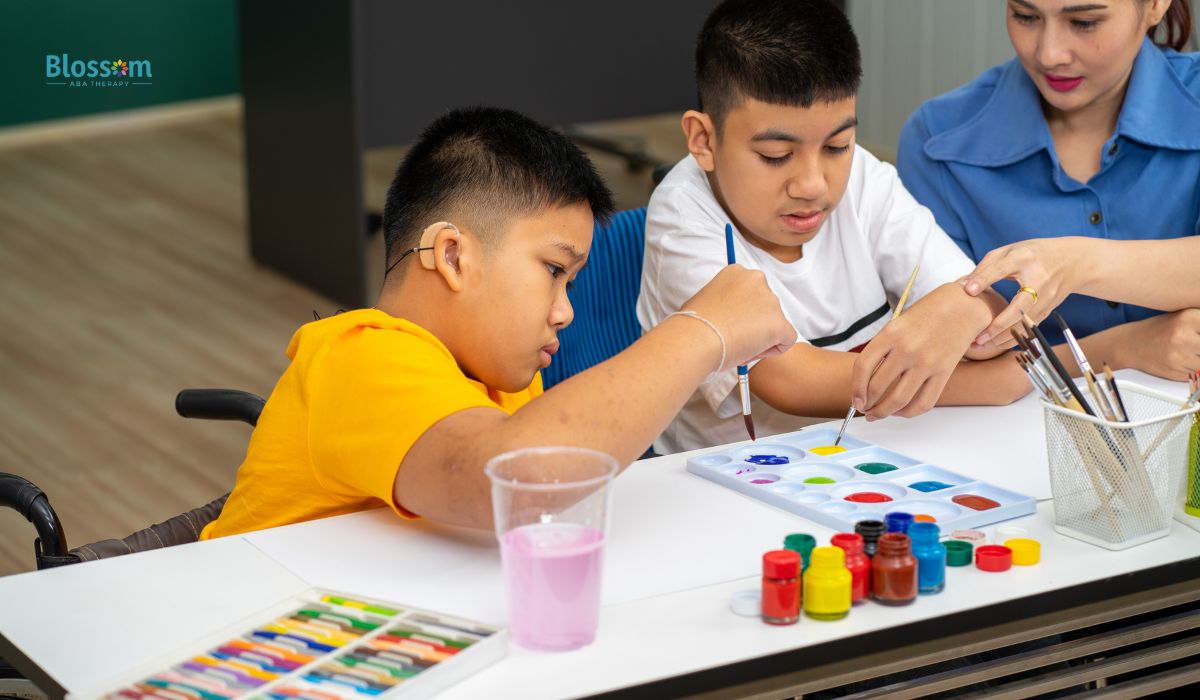
Children and Autism: Early Signs, Symptoms, and Diagnosis
Feb 14, 2024
Discover the process and importance of ASD Diagnosis in children. Read on to learn about early symptoms, signs and detection.

Autism, or Autism Spectrum Disorder in children, has gained notable attention recently.
This developmental disorder can profoundly impact a child’s life and their family.
Early detection and diagnosis are essential to ensure children with autism get the necessary support and early intervention.
This article will delve into the early signs and diagnosis of autism in children, providing valuable insights for parents, caregivers, and educators.
What is Autism in Children?
Autism, known as Autism Spectrum Disorder, is a complex neurodevelopmental condition that affects a child’s social interaction, communication, behavior, and interests.
It is a “spectrum” disorder encompassing various symptoms and severity levels.
While every child with autism is unique, they often share certain common traits and challenges.
Autism is a lifelong condition that can persist into adulthood.
The severity of symptoms can vary broadly, with some individuals requiring minimal support while others may need intensive interventions and care throughout their lives.
Early Signs of Autism in Children
Identifying the early signs of autism in children is essential for early intervention and support.
Here are some key indicators to look out for:
Social Challenges
Children with autism may exhibit difficulties in social interactions.
They may have trouble making eye contact, responding to their name, or engaging in typical social play with peers.
They might seem aloof or disinterested in other people.
Communication Difficulties

Language and communication difficulties are common in children with autism.
Some may have delayed speech or struggle to express themselves verbally.
Others may have difficulty understanding non-verbal cues like facial expressions and body language.
Repetitive Behaviors
Repetitive behaviors are a hallmark of autism in children.
These behaviors can include hand-flapping, rocking, repeating words or phrases (echolalia), or having intense fixations on specific objects or topics.
Repetitive behaviors can serve as a way for children with autism to self-soothe or cope with sensory overload.
These behaviors may appear unusual to others but have a purpose for the child.
Difficulty with Transitions
Children with autism may struggle to adapt to routine changes or transitions between activities.
They may become upset or anxious when faced with unexpected changes.
To help children with autism cope with transitions, providing visual schedules or warnings about upcoming changes in activities is beneficial.
This can help ease their anxiety and make transitions smoother.
Sensory Sensitivities
Many children with autism have heightened sensory sensitivities.
They may be overreactive or underreactive to sensory stimuli such as lights, sounds, textures, or tastes.
This can lead to sensory overload or seeking sensory stimulation.
Understanding a child’s sensory sensitivities can help parents and caregivers create more comfortable and less overwhelming environments.
Lack of Pretend Play
Typically, developing children engage in pretend play, such as acting to cook or have a tea party.
Children with autism may struggle with imaginative or pretend play and prefer repetitive or solitary activities.
Engaging in play-based interventions that encourage creativity and social interaction can be beneficial for children with autism.
Limited Eye Contact
Difficulty with maintaining eye contact is a common early sign of autism.
Children may avoid eye contact or only briefly make it during interactions.
While limited eye contact is a characteristic of autism, it’s important to note that it doesn’t reflect the child’s level of interest or affection.
Some children with autism may express their feelings and intentions in different ways.
Delayed Speech and Language
Delayed speech and language development are frequently observed in children with autism.
Some may not start speaking until later than expected, and others may struggle with speech clarity.
Speech therapy can benefit children with autism who experience speech and language delays.
Early intervention with a speech therapist can help improve communication skills.
Inability to Understand Emotions
Children with autism may struggle to recognize and understand the emotions of others.
This can make it challenging for them to empathize and respond appropriately in social situations.
Visual supports, such as emotion cards with facial expressions, can aid children with autism in recognizing and understanding emotions in themselves and others.
Fixation on Routine
Many children with autism find comfort in routine and may become upset when their daily schedule is disrupted.
They may insist on following the same patterns and rituals.
Creating a structured and predictable routine can provide security for children with autism.
Visual schedules and timers can help them anticipate transitions and changes in activities.
The Importance of Early Diagnosis
Early diagnosis of autism in children is critical for several reasons:
Early Intervention: The earlier autism is identified, the sooner interventions can begin.
Furthermore, Early intervention services, such as speech therapy, behavioral therapy, and occupational therapy, can help children develop essential skills and reduce the impact of their symptoms.
Improved Outcomes: Research shows that children who receive early intervention have better communication, social interaction, and behavior outcomes.
Early diagnosis can lead to better long-term prospects for a child with autism.
Support for Families: An early diagnosis provides families with the knowledge and resources to support their child effectively.
It can also connect them with support networks and advocacy groups.
Individualized Education Plans (IEPs): Early diagnosis can lead to the development of Individualized Education Plans (IEPs) tailored to the child’s needs. These plans help educators provide appropriate support and accommodations in school.
Early diagnosis not only benefits the child but also their family and the community as a whole.
It enables individuals with autism to lead more fulfilling lives and participate more actively in society.
Diagnosing Autism in Children
Diagnosing autism in children is a multi-step process that involves careful observation and evaluation.
Here’s how the diagnosis typically unfolds:
Developmental Screening
Pediatricians often perform developmental screenings during routine well-child visits.
These screenings assess a child’s development in critical areas such as communication, social skills, and behavior.
If any concerns arise during these screenings, further evaluation is recommended.
Developmental screenings are a valuable tool for identifying potential signs of autism early on.
They provide a starting point for further assessment if needed.
Comprehensive Evaluation
A comprehensive evaluation is conducted by professionals, including pediatricians, psychologists, and speech and language therapists.
This evaluation assesses the child’s behavior, communication skills, social interactions, and developmental history.
Parents or caregivers are usually interviewed to provide valuable insights into the child’s behavior at home.
Collaboration among professionals ensures a thorough assessment considering all aspects of the child’s development and behavior.
Diagnostic Criteria
To receive a diagnosis of autism, a child must meet specific criteria outlined in the Diagnostic and Statistical Manual of Mental Disorders (DSM-5).
These criteria consider the child’s social communication difficulties and repetitive behaviors.
The DSM-5 criteria help ensure consistency in diagnosis and enable healthcare providers to make accurate assessments.
Differential Diagnosis
During the evaluation process, professionals also consider other conditions that may present with similar symptoms, such as intellectual disabilities, speech disorders, or sensory processing disorders.
A thorough assessment helps rule out these conditions.
A differential diagnosis is essential to ensure the child receives appropriate interventions and support.
Ongoing Monitoring

Once an autism diagnosis in children is received, ongoing monitoring and assessment are essential.
This ensures that the child’s progress is tracked and any necessary adjustments to interventions or therapies can be made.
Regular monitoring allows for modifications to the child’s treatment plan as they grow and develop, ensuring their needs are effectively met.
Conclusion
Autism in children is a complex and diverse condition that requires early detection and diagnosis for effective intervention.
By recognizing the early signs and seeking professional evaluation, parents and caregivers can provide the necessary support and resources to help children with autism reach their full potential.
Recognizing early signs and ensuring timely diagnosis and intervention is pivotal for a brighter future for children with autism.
Frequently Asked Questions (FAQs)
What are the potential causes of autism in children?
The exact cause of autism is unknown, but it is believed to result from genetic and environmental factors. Autism is a complex condition with multiple contributing factors. While genetic predisposition plays an important role, environmental factors also impact its development.
At what age is autism typically diagnosed in children?
Autism can be identified as early as 18 months, although some children may not be diagnosed until they are older. Early diagnosis is crucial for accessing early intervention services and support. The earlier autism is identified, the better the outcomes can be.
Can children outgrow autism, or is there a cure?
Autism is a lifelong condition, but early intervention and therapy can help children develop essential skills and improve their quality of life. While autism cannot be cured, individuals with autism can make significant progress with appropriate interventions and support.
How can I help my child with autism at home?
You can support your child with autism by creating a structured and predictable routine, providing sensory-friendly environments, and seeking guidance from therapists and specialists.
What medical tests are used to diagnose autism in children?
There is no single medical test for diagnosing autism. Diagnosis is typically based on behavioral observations and evaluations. Diagnosing autism relies on comprehensive assessments and statements of a child’s behavior and development.
What are the standard therapies and treatments for children with autism?
Standard therapies for children with autism include Applied Behavior Analysis (ABA), speech therapy, occupational therapy, and social skills training. Treatment choice depends on the child’s specific needs and goals; a multidisciplinary approach is often recommended.
Can children with autism attend regular schools?
Many children with autism can attend regular schools with appropriate support and accommodations. Individualized Education Plans (IEPs) are often used to tailor education to their needs. Inclusion in mainstream educational settings can benefit children with autism when appropriate support is provided.
Do all children with autism have the same symptoms?
No, autism is a spectrum disorder, and symptoms can vary widely from one child to another. Each child with autism is unique. The diversity of symptoms within the autism spectrum highlights the importance of individualized assessments and interventions.
Is there a cure for autism?
There is no cure for autism, but early intervention and therapy can significantly improve a child’s development and quality of life. While no cure exists, early intervention can substantially improve a child’s abilities and overall well-being.
What support is available for families of children with autism?
Families of children with autism can access support through advocacy groups, parent training programs, and therapy services. It’s essential to connect with local resources and support networks. Support networks can provide valuable guidance, information, and emotional support for families navigating the challenges of autism.
Autism Diagnosis in Children Explained | Blossom ABA Therapy
News & Blogs





